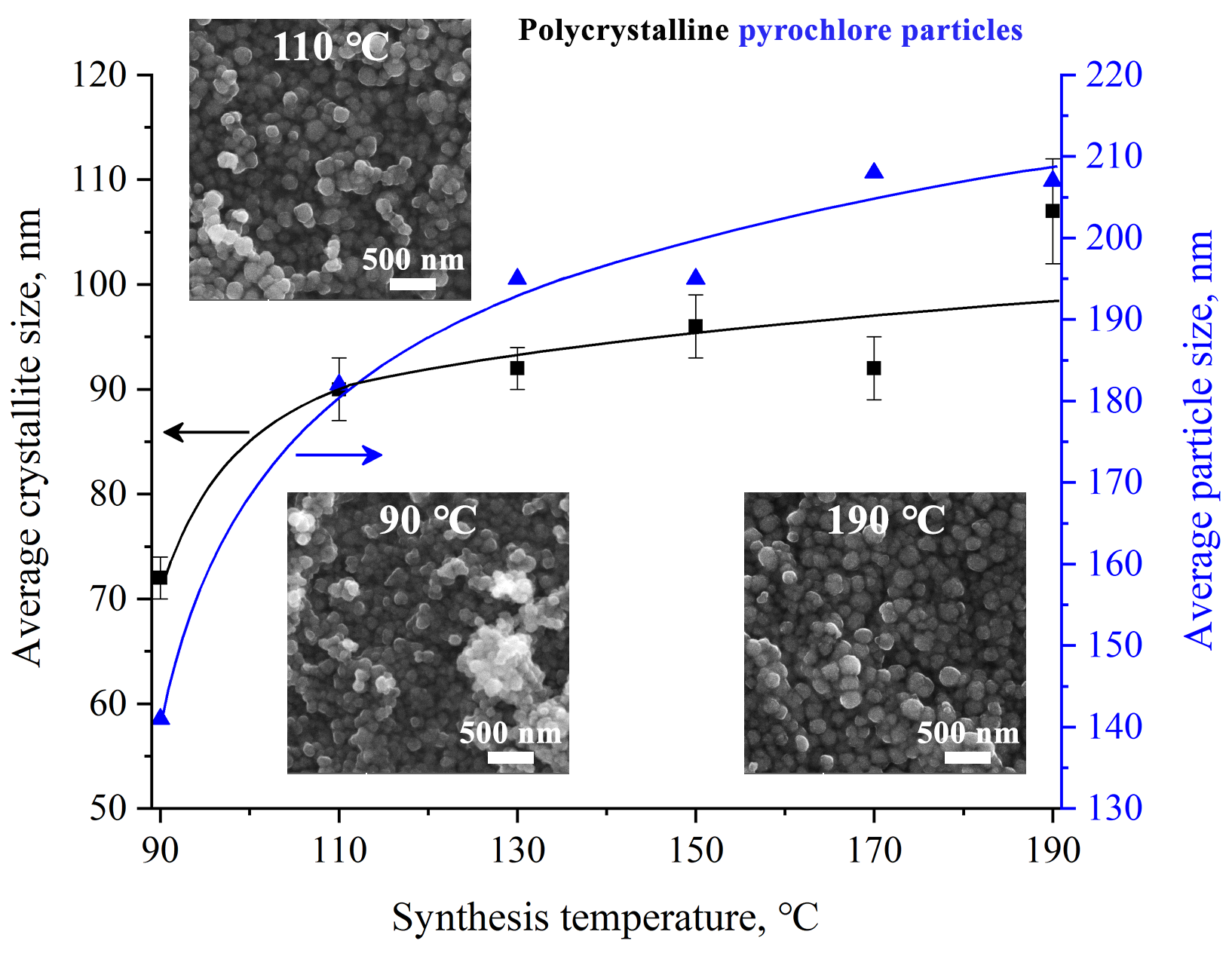Nanosystems: Phys. Chem. Math., 2023, 14 (2), 242–253
Pyrochlore phase in the Bi2O3–Fe2O3–WO3–(H2O) system: its formation by hydrothermal synthesis in the low-temperature region of the phase diagram
Makariy S. Lomakin – Ioffe Institute, St. Petersburg; St. Petersburg Electrotechnical University “LETI”, St. Petersburg, Russia; lomakinmakariy@gmail.com
Olga V. Proskurina – Ioffe Institute, St. Petersburg; St. Petersburg State Institute of Technology, St. Petersburg, Russia; proskurinaov@mail.ru
Victor V. Gusarov – Ioffe Institute, St. Petersburg, Russia; victor.v.gusarov@gmail.com
Corresponding author: Makariy S. Lomakin, lomakinmakariy@gmail.com
DOI 10.17586/2220-8054-2023-14-2-242-253
ABSTRACT The present paper investigates features of a (Bi, Fe, •)2(Fe, W)2O6O’δ cubic pyrochlore-structured phase (hereinafter BFWO) formation in the Bi2O3–Fe2O3–WO3–(H2O) system under the hydrothermal synthesis conditions at T < 200 °C and in the range of pH < 1. It was found that the BFWO phase is formed even when the amorphous precursor suspension is less than 100 °C. The BFWO phase particles have a conditionally spherical morphology and are polycrystalline. The dependency of the average particle size on the synthesis temperature correlates well with the dependency of the average crystallite size on this parameter: both values increase abruptly with an increase in the amorphous precursor suspension treatment temperature from 90 to 110 °C (from ~140 and 70 nm to ~180 and 90 nm, respectively), and with a further increase in the hydrothermal treatment temperature to 190 °C, they increase more smoothly (up to ~210 and 110 nm, respectively). It was found that the average number of crystallites in a particle is ~9 units regardless of the synthesis temperature, i.e. an increase in the BFWO phase particle size with the increasing temperature (in the considered temperature range) occurs mainly due to an increase in the size of their constituent crystallites.
KEYWORDS pyrochlore-structured phase, hydrothermal synthesis, phase formation, nanocrystals.
ACKNOWLEDGEMENTS The authors are grateful to D.P. Danilovich for assistance in performing the synthetic part of the work. XRD studies, SEM and EDXMA of samples were performed employing the equipment of the Engineering Center of the St. Petersburg State Institute of Technology (Technical University). The work was financially supported by the Russian Science Foundation (Project No. 20-63-47016).
FOR CITATION Lomakin M.S., Proskurina O.V., Gusarov V.V. Pyrochlore phase in the Bi2O3–Fe2O3–WO3–(H2O) system: its formation by hydrothermal synthesis in the low-temperature region of the phase diagram. Nanosystems: Phys. Chem. Math., 2023, 14 (2), 242–253.
[In Russian] М.С. Ломакин, О.В. Проскурина, В.В. Гусаров
Фаза пирохлора в системе Bi2O3–Fe2O3–WO3–(H2O): формирование в условиях гидротермального синтеза в низкотемпературной области фазовой диаграммы
УДК 54.057:542.468:661.887:661.878:661.872.2
АННОТАЦИЯ В работе исследованы особенности формирования фазы со структурой кубического пирохлора (Bi, Fe, •)2(Fe, W)2O6O’δ (далее ‒ BFWO) в системе Bi2O3–Fe2O3–WO3–(H2O) в условиях гидротермального синтеза при T < 200 °C и в области значений pH < 1. Установлено, что фаза BFWO формируется даже в том случае, когда температура обработки суспензии аморфного прекурсора составляет менее 100 °C. Частицы фазы BFWO имеют условно сферическую морфологию и являются поликристаллическими. Зависимость среднего размера частиц фазы BFWO от температуры хорошо коррелирует с зависимостью от этого параметра среднего размера кристаллитов ‒ обе величины скачкообразно увеличиваются при повышении температуры обработки суспензии аморфного прекурсора от 90 до 110 °C (от ~ 140 и 70 нм до ~ 180 и 90 нм соответственно), а при дальнейшем повышении температуры гидротермальной обработки до 190 ℃ возрастают уже более плавно (до ~ 210 и 110 нм соответственно). Показано, что среднее число кристаллитов в частице составляет ~ 9 ед. в независимости от температуры синтеза, т.е. увеличение размеров частиц фазы BFWO при повышении температуры (в рассмотренном температурном диапазоне) происходит преимущественно за счёт увеличения размеров составляющих их кристаллитов.
КЛЮЧЕВЫЕ СЛОВА Фаза со структурой пирохлора, гидротермальный синтез, фазообразование, нанокристаллы
